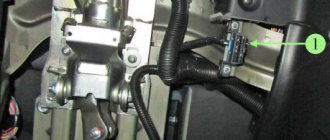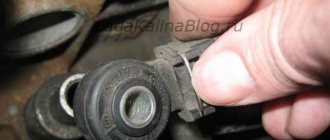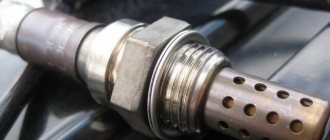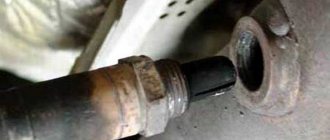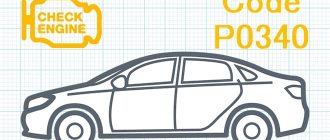What does P0134 mean?
The oxygen sensor monitors the oxygen content in the vehicle's exhaust gases. It sends a signal to the transmission control module (PCM), which in turn uses the information received to regulate the ratio of fuel and air mixture supplied to the engine cylinders.
When there is insufficient oxygen in the exhaust gases, the vehicle's PCM reduces the amount of fuel used by the engine. This is important because if there is not enough oxygen in the exhaust gases, fuel consumption increases, as well as the amount of harmful substances emitted from the vehicle's exhaust gases.
When there is insufficient fuel, the vehicle's PCM increases the amount of fuel used by the engine. This is also quite important because if there is not enough fuel, hydrocarbons and nitrogen oxides will be released into the atmosphere.
Why is a lambda probe needed in a car, location
A lambda probe is necessary to measure the oxygen content coefficient in a combustible mixture. It is always installed in the area of the exhaust pipe before the catalyst and measures the volume of unburned oxygen in the combustion products. This information will allow the ECU to prepare the optimal mixture.
A mixture containing 14.7 parts air and one part fuel burns most efficiently. These are optimal indicators; if oxygen is present in large quantities, then the mixture is lean; if there is less air, then it is rich.
Combustion of a rich mixture is less efficient - a decrease in power and increased fuel consumption can be observed.
Since the engines in cars operate in completely different modes, the optimal ratio of air and fuel may not be observed. Oxygen sensors are used to control the quality of the mixture in power systems.
Based on the signals from the lambda, the ECU can assess the quality of the mixture. If indicators are found that do not meet the standards, the mixture is adjusted.
Operating principle of the oxygen sensor
The principle of operation of the oxygen sensor is quite simple. The lambda probe must compare the readings with some ideal results in order to understand how the percentage of oxygen in the mixture changes, so measurements are taken in two places - atmospheric air and combustion products .
This approach allows the sensor to feel the difference if the fuel mixture ratio changes.
The ECU must receive an electrical impulse from the lambda probe. To do this, the sensor must be able to convert measurements into electrical signals. For measurements, special electrodes are used that can react with oxygen.
Lambda uses the principle of galvanic cells - changing the conditions of chemical reactions leads to a change in the voltage between the two electrodes. When the mixture is rich and the oxygen content is below the lower threshold, then the voltage rises. If the mixture is lean, the voltage will drop.
Next, the impulse that occurs at the stage of chemical reactions is sent to the ECU, where the parameters are compared with the fuel maps stored in the memory. As a result, the operation of the power system is adjusted.
The oxygen sensor operates on chemical reactions, but its design is relatively simple. The main element is a special tip made of ceramic materials. Zirconium dioxide and, less commonly, titanium dioxide are used as raw materials.
The tip is coated with platinum - it is this layer that reacts with oxygen. One side of this tip is in contact with the exhaust gases, the other side with the air in the atmosphere.
This is interesting: Wear of oil seals (valve seals): how to replace without removing the head
The lambda probe electrodes have one feature. So that the reaction is more efficient and the indicators are accurate, measurements of the oxygen content in the exhaust are carried out under certain temperatures.
In order for the tip to reach the performance characteristics and the required electrical conductivity, the temperature of the environment should be 300-400 degrees.
To ensure the required temperature regime, the lambda probe was initially installed in close proximity to the exhaust manifold. This ensured the desired temperature after warming up the internal combustion engine. The sensor did not start working immediately. Before the lambda warmed up enough and began to produce accurate parameters, the ECU used signals from other sensors. The optimal mixture was not prepared during the heating process.
Some oxygen sensor models are equipped with electric heaters. Thanks to them, the lambda can quickly reach operating temperature conditions. Heating uses energy from the vehicle's on-board network.
What does the error indicate?
The error with this code is quite common and is not considered particularly complex. Such a notification tells the driver that the information coming from the first oxygen sensor is incorrect or is issued with violations. You can diagnose the supply of incorrect information from the sensor to the ECU as follows:
- When the signal from the oxygen sensor is low, the information is transferred to the ECU memory and recorded;
- The data is sent to the ECU and recorded if there are no changes in the information from the oxygen sensor;
- The vehicle's check light comes on when the violation is permanent.
What are the symptoms of code P0134?
In some cases, there may be no symptoms other than a stored DTC and CHECK ENGINE light. On the other hand, some consequences may be so severe in other cases that the vehicle becomes undriveable.
Also keep in mind that the severity of one or more symptoms may vary from vehicle to vehicle.
- Serious problems while driving: severe loss of power, unstable acceleration, the car may even stall unexpectedly.
- Increased fuel consumption, which can range from slight and barely noticeable to significant.
- Black smoke from the muffler.
- Difficult start.
- Reduced spark plug life.
- In extreme cases, reduced engine longevity is caused by an excessively rich fuel mixture, which washes away the protective lubricant film from the cylinder walls.
Causes of error P0134
When the oxygen sensor is working properly, it will give a reading (in millivolts) that fluctuates up and down. If the PCM detects that the sensor readings are not changing, it will store a code P0134. The most common causes of this error are:
- Oxygen sensor heater circuit malfunction
- Loose or damaged electrical wires related to the oxygen sensor
- Corroded oxygen sensor connector
- Worn or damaged vacuum hoses
- Malfunction of the automatic transmission control module (PCM)
How does a mechanic diagnose a P0134 code?
First, the mechanic will connect the OBD-II scanner to the vehicle's diagnostic port and read all stored data and error codes to determine when and under what circumstances the P0134 code occurred. He will then clear the error codes from the computer's memory and test drive the car.
To determine if the P0134 code appears again, the vehicle must reach normal operating temperature. If the error code appears again, a mechanic will check the electrical wires and oxygen sensor connector for corrosion or damage. The mechanic will also monitor the oxygen sensor readings in real time using a scanner. This will help determine if the sensor is working properly.
If necessary, a mechanic will replace the faulty oxygen sensor. It should be noted that in rare cases, the problem may be a faulty transmission control module (PCM).
Replacing the lambda probe
In most cases, a part such as a lambda probe cannot be repaired, as evidenced by statements about the impossibility of repair from many automobile manufacturers. However, the inflated cost of such a unit from official dealers discourages anyone from purchasing it. The optimal way out of this situation could be a universal sensor, which costs much less than its native analogue and is suitable for almost all car brands. Also, as an alternative, you can purchase a used sensor, but with a warranty period, or a completely exhaust manifold with a lambda probe installed in it.
However, there are cases when the lambda probe operates with a certain error due to severe contamination as a result of combustion products deposited on it. In order to make sure that this is really the case, the sensor must be checked by specialists. After the lambda probe has been checked and its full functionality has been confirmed, it must be removed, cleaned and reinstalled.
This is interesting: Design of the master brake cylinder of a passenger car and replacement of the repair kit
In order to dismantle the oxygen level sensor, it is necessary to warm its surface to 50 degrees. After removal, the protective cap is removed from it and only after that you can start cleaning. It is recommended to use phosphoric acid as a highly effective cleaning agent, which can easily cope with even the most stubborn flammable deposits. At the end of the soaking procedure, the lambda probe is rinsed in clean water, thoroughly dried and installed in place. At the same time, do not forget about lubricating the threads with a special sealant, which will ensure complete tightness.
The structure of a car is very complex, so it needs constant maintenance and timely preventative maintenance. Therefore, if there is a suspicion that the lambda probe is faulty, it is necessary to immediately diagnose its performance and, if the fact of failure is confirmed, replace the lambda probe. Thus, all the most important functions of the vehicle will be maintained at the same level, which will guarantee the absence of further problems with the engine and other important elements of the car.
Replacement problems
When replacing, the old sensor may stick to the pipe. In this case, proceed like this:
- Apply wd-40 generously and try to unscrew
- Turn on the engine, heat the exhaust system and unscrew the sensor
- We try to heat (being careful) the sensor itself and unscrew it
- Tap lightly with a hammer and try to unscrew it again
- If that doesn't help, try thermal shock. Pour cold water onto the well-heated sensor. Try unscrewing it again.
Oxygen sensor price
The price of an oxygen sensor will vary by region and model. It ranges from 1000 to 3000 rubles . Buy a lambda probe in specialized stores and only with a guarantee.
What repairs can fix the P0134 code?
To resolve this error you may need to:
- Check for the error code using a scan tool, clear the code from your computer's memory, and test drive the vehicle to see if the P0134 error code appears again and the Check Engine light comes on.
- Repair or replacement of electrical wires or oxygen sensor connector
- Replacing a faulty oxygen sensor
- Check and, if necessary, repair or replace the exhaust pipe or oxygen sensor heater fuse
Additional comments for troubleshooting P0134
Although the most common cause of the P0134 code is a faulty oxygen sensor, before replacing the sensor, you must perform a thorough diagnosis and consider all possible causes of the error. First of all, you need to check the electrical wires and the oxygen sensor connector.
Each time after repair work is performed, it is necessary to clear the error codes from the computer's memory and test drive the vehicle to find out if the P0134 error appears again. This will help determine if the problem is resolved.
If during the diagnosis it turns out that everything is in order with the oxygen sensor, as well as the corresponding electrical wires and connector, it is necessary to check the exhaust pipe and the sensor heater fuse.
It should be noted that in rare cases, the problem may be a faulty transmission control module (PCM).
Common causes of violation
Error P0134 does not occur very often. There are few probable reasons for the occurrence of such a violation, and they all indicate an incorrect signal from a specific sensor. Based on this, you can determine the most popular options for the occurrence of error P0134:
- Presence of a short circuit;
- Oxygen sensor malfunction;
- Broken wires and oxidation of contacts.
During diagnostics using special equipment, the causes of the malfunction are identified quite quickly and accurately. In most cases, this violation is provoked by a breakdown of the oxygen sensor and in 5% of them the malfunction is directly related to a short circuit, an open circuit and the presence of oxidation processes in the contacts.
In situations where, along with the error in question, the presence of errors with code P0171 is also displayed, we can conclude that there is a possibility of a break or short circuit. The second error in most cases appears when the air-fuel mixture entering the engine is too lean. It is often accompanied by error code P0134, since in the exhaust circuit the first oxygen sensor is directly responsible for the supply. When the information supply stops, the ECU spontaneously reduces the fuel consumption. Thus, the air-fuel mixture becomes lean.
This is interesting: Replacing the low beam lamp on a Nissan JUKE, photo and video instructions

